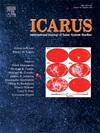The influence of passing field stars on the solar system’s dynamical future
IF 2.5
2区 物理与天体物理
Q2 ASTRONOMY & ASTROPHYSICS
引用次数: 0
Abstract
The long-term dynamical future of the Sun’s planets has been simulated and statistically analyzed in great detail, but most prior work considers the solar system as completely isolated, neglecting the potential influence of field star passages. To understand the dynamical significance of field star encounters, we simulate several thousand realizations of the modern solar system in the presence of passing field stars for 5 Gyrs. We find that the impulse gradient of the strongest stellar encounter largely determines the net dynamical effect of field stars. Because the expected strength of such an encounter is uncertain by multiple orders of magnitude, the possible significance of field stars can be large. Our simulations indicate that isolated models of the solar system can underestimate the degree of our giant planets’ future secular orbital changes by over an order of magnitude. In addition, our planets and Pluto are significantly less stable than previously thought. Field stars transform Pluto from a completely stable object over 5 Gyrs to one with a 5% instability probability. Furthermore, field stars increase the odds of Mercury’s instability by 50%–80%. We also find a 0.3% chance that Mars will be lost through collision or ejection and a 0.2% probability that Earth will be involved in a planetary collision or ejected. Compared to previously studied instabilities in isolated solar systems models, those induced by field stars are much more likely to involve the loss of multiple planets. In addition, they typically happen sooner in our solar system’s future, making field star passages the most likely cause of instability for the next 4–4.5 Gyrs.
经过的场星对太阳系动态未来的影响
太阳行星的长期动态未来已经被非常详细地模拟和统计分析,但大多数先前的工作认为太阳系是完全孤立的,忽略了场恒星通道的潜在影响。为了理解场星相遇的动力学意义,我们模拟了现代太阳系在经过场星的情况下的几千次实现,时间长达5年。我们发现最强恒星碰撞的脉冲梯度在很大程度上决定了场星的净动力学效应。由于这种相遇的预期强度在多个数量级上是不确定的,因此野星的可能意义可能很大。我们的模拟表明,太阳系的孤立模型可以低估我们的巨行星未来长期轨道变化的程度,其幅度超过一个数量级。此外,我们的行星和冥王星比之前认为的要不稳定得多。野星将冥王星从一个完全稳定的天体转变为一个具有~ 5%不稳定概率的天体。此外,磁场恒星增加了水星不稳定的几率约50%-80%。我们还发现,火星因碰撞或抛射而消失的可能性为~ 0.3%,地球因行星碰撞或抛射而消失的可能性为~ 0.2%。与先前研究的孤立太阳系模型的不稳定性相比,由磁场恒星引起的不稳定性更有可能涉及多个行星的损失。此外,它们通常会在我们太阳系的未来发生得更快,这使得磁场恒星通过最有可能成为未来4-4.5 gyr不稳定的原因。
本文章由计算机程序翻译,如有差异,请以英文原文为准。
求助全文
约1分钟内获得全文
求助全文
来源期刊

Icarus
地学天文-天文与天体物理
CiteScore
6.30
自引率
18.80%
发文量
356
审稿时长
2-4 weeks
期刊介绍:
Icarus is devoted to the publication of original contributions in the field of Solar System studies. Manuscripts reporting the results of new research - observational, experimental, or theoretical - concerning the astronomy, geology, meteorology, physics, chemistry, biology, and other scientific aspects of our Solar System or extrasolar systems are welcome. The journal generally does not publish papers devoted exclusively to the Sun, the Earth, celestial mechanics, meteoritics, or astrophysics. Icarus does not publish papers that provide "improved" versions of Bode''s law, or other numerical relations, without a sound physical basis. Icarus does not publish meeting announcements or general notices. Reviews, historical papers, and manuscripts describing spacecraft instrumentation may be considered, but only with prior approval of the editor. An entire issue of the journal is occasionally devoted to a single subject, usually arising from a conference on the same topic. The language of publication is English. American or British usage is accepted, but not a mixture of these.
 求助内容:
求助内容: 应助结果提醒方式:
应助结果提醒方式:


